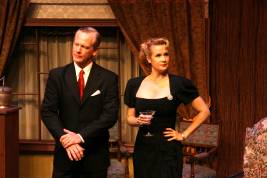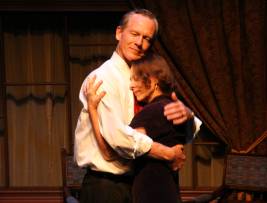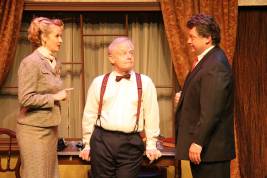
The Republican Party has lost control of the White House and wants it back in the next election. “If we get a strong candidate, we’ve got a better than fighting chance,” remarks newspaper publisher Kay Thorndyke at a meeting with party bigwig James Conover and reporter/political strategist Spike MacManus. “The party’s best chance is to put up a candidate who’s never been identified with politics,” Kay goes on, and the trio set their sights on wealthy, self-made tycoon Grant Matthews. It just so happens that Kay and Grant have been carrying on an affair under the nose of Grant’s justifiably suspicious wife Mary, but no matter. What the public doesn’t know won’t hurt the Republican candidate, whoever he may turn out to be. Now, if they can just get Grant and Mary to play the parts of happily married man and wife and persuade Grant to tone down those speeches that have riled the special interest groups, thereby presenting a more homogenized image to the American public, they may just have an electable candidate.
Sound familiar? Change the names, and the election in question just might be the one two years from now.
In fact, however, the presidential election Conover and his cronies are hoping to win is 1948’s, and Kay, Conover, Grant, and Mary are all fictitious characters in Russel Crouse and Howard Lindsay’s 1945 Pulitzer Prize-winning State Of The Union, a political comedy now being revived—terrifically—by Interact Theatre Company.
Though the issues of the day (the earliest stages of the Cold War, concern over the atomic bomb, debate over America’s inclusion in the United Nations) may not be exactly the same ones that Americans have on their minds in 2010, the back room finagling and devious strategizing used to get a candidate elected are as contemporary as this year’s midterm elections. For a play written sixty-five years ago, State Of The Union seems surprisingly undated despite the absence of cell phones, the Internet, and television.
Under Anita Khanzadian’s pitch-perfect direction and aided by Meagan Evers pitch-perfect period costumes, the entire cast* do splendid work capturing the look and feel of the period between the end of World War II and the Eisenhower ‘50s.
A trio of leading ladies get arguably the most colorful roles, and each is a standout. D.J. Harner’s Mary is the perfect blend of assertive and vulnerable, the LA. stage favorite making her period role seem contemporary without sacrificing historical accuracy. As Kay, versatile musical theater performer/choreographer Tracy Powell does some of her very best work yet—glamour and smarts personified in a non-singing/non-dancing role no less. Elizabeth Herron milks each syllable of Lulubelle’s infectious Southern drawl for all its worth, and downs a shitload of Sazeracs with the best of them. (It turns out that the Sazerac is the very first cocktail ever invented in America—way down South in Dixie. Who knew?)
As Grant, Don Fischer not only looks like every campaign manager’s dream candidate, he has precisely the right voice and bearing for the role. Stick James Gleason (Conover) into a smoke-filled room of politicos and he’d seem right at home, and the same could be said about James Calvert (Spike) in a room full of newspaper reporters. In smaller roles, Steven Connor (Judge Alexander), Eddie Jones (Sam Parrish), Stephen Richmond (Bill Hardy), and Paul Anderson (Senator Lauterback) could easily have stepped out of a Turner Classic Movie of the 1940s. Mimi Cozzens is a standout in a pair of roles she deliniates so completely (maid Norah and political wife Mrs. Draper) that you’d never know they were being played by the same actress. Colin Thomas Jennings sparkles as Stevens/Bellboy as does a very funny Erin Parks, slyly underplaying maid Jenny’s tipsiness. Kendall Linzee is effective in the role of Swenson.
Besides costume designer Evers’ late ‘40s garb, Joel Daavid’s set design (which morphs into a different room for each of State Of The Union’s three acts) contributes greatly to the mid-Twentieth Century look of the production. Derrick McDaniel’s lighting, Ron Klier’s sound design, and Marc Fellnererez’, Calvert’s, and Michael Thatcher’s props also merit thumbs up, though an anachronistic seltzer bottle and coiled phone cord do ring a tad false. Carla Barnett is producer, Cassandra Capoferri assistant director and Darryl Johnson stage manager.
If there’s anything wrong with State Of The Union (the title refers both to the U.S. and to the Matthews’ marital union, if you hadn’t already caught on), it’s simply that at three acts and nearly three hours, it may be too much for the 2010 theatergoer accustomed to ninety minutes without an intermission and we’re on our way home. Then again, it’s hard to complain about writing, direction, and acting as incisive and even timeless as that now gracing the NoHo Arts Center stage. The state of this State Of The Union is very fine indeed.
*The roles of Mary, Lulubelle, and Norah/Mrs. Draper have been double cast, and understudies have been assigned to the roles of Grant, Kay, Spike, and Conover.
Interact Theatre Company, NoHo Arts Center, 11136 Magnolia Boulevard, North Hollywood.
www.interactla.org
–Steven Stanley
September 26, 2010
Photos: Carla Barnett





 Since 2007, Steven Stanley's StageSceneLA.com has spotlighted the best in Southern California theater via reviews, interviews, and its annual StageSceneLA Scenies.
Since 2007, Steven Stanley's StageSceneLA.com has spotlighted the best in Southern California theater via reviews, interviews, and its annual StageSceneLA Scenies.







 COPYRIGHT 2024 STEVEN STANLEY :: DESIGN BY
COPYRIGHT 2024 STEVEN STANLEY :: DESIGN BY